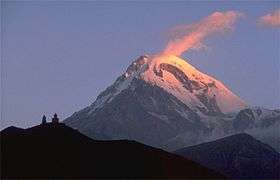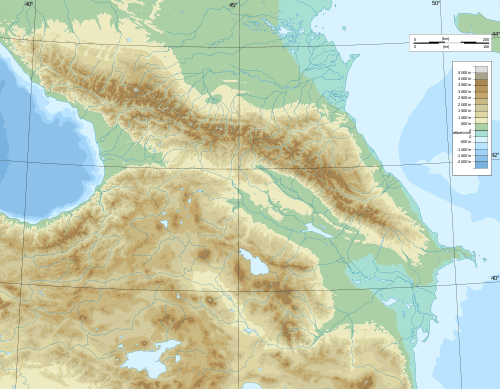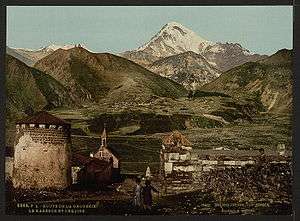Mount Kazbek
| Mount Kazbek | |
|---|---|
 Mount Kazbek | |
| Highest point | |
| Elevation | 5,047 m (16,558 ft) [1][2] |
| Prominence | 2,353 m (7,720 ft) [1] |
| Listing | Ultra |
| Coordinates | 42°41′57″N 44°31′06″E / 42.69917°N 44.51833°ECoordinates: 42°41′57″N 44°31′06″E / 42.69917°N 44.51833°E [1] |
| Geography | |
 Kazbek Location of Mount Kazbek within the Caucasus mountains | |
| Location | |
| Parent range | Caucasus |
| Geology | |
| Mountain type | Stratovolcano (dormant) |
| Last eruption | 750 BCE ± 50 years |
| Climbing | |
| First ascent | 1868 by Douglas Freshfield, A. W. Moore, C. C. Tucker and François Devouassoud |
| Easiest route | basic snow/ice climb |
Mount Kazbek (or Kazbegi, Georgian: ყაზბეგის მყინვარწვერი, Qazbegis mqinvarċveri), is a dormant stratovolcano and one of the major mountains of the Caucasus located in the Kazbegi District of Georgia,[4] just south of the border with Russia.
It is the third-highest peak in Georgia (after Mount Shkhara and Janga) and the seventh-highest summit in the Caucasus Mountains. Kazbek is also the second-highest volcanic summit in the Caucasus, after Mount Elbrus. The summit lies directly to the west of the town of Stepantsminda and is the most prominent geographic feature of the area. Mount Kazbek is the highest peak of Eastern Georgia. The name in Georgian, Mkinvartsveri, translates to "Glacier Peak" or "Freezing Cold Peak".[5] The Vainakh name Bashlam translates as "Molten Mount".
Location
Kazbek is located on the Khokh Range, a mountain range which runs north of the Greater Caucasus Range, and which is pierced by the gorges of the Ardon and the Terek. At its eastern foot runs the Georgian Military Road through the pass of Darial 2,378 meters (7,805 feet). The mountain itself lies along the edge of the Borjomi-Kazbegi Fault (which is a northern sub-ending of the Anatolian Fault). The region is highly active tectonically, with numerous small earthquakes occurring at regular intervals. An active geothermal/hot spring system also surrounds the mountain. Kazbek is a potentially active volcano, built up of trachyte and sheathed with lava, and has the shape of a double cone, whose base lies at an altitude of 1,770 meters (5,800 feet). Kazbek is the highest of the volcanic cones of the Kazbegi volcanic group which also includes Mount Khabarjina (3,142 metres).
Owing to the steepness of its slopes, the glaciers of Kazbek are not very large. The total combined area of all of Kazbek's glaciers is 135 km². The best-known glacier is the Dyevdorak (Devdaraki), which creeps down the north-eastern slope into a gorge of the same name, reaching a level of 2,295 meters (7,530 feet). Kazbek's other glaciers include the Mna, Denkara, Gergeti, Abano, and Chata. The recent collapse of the Kolka Glacier, located in a valley between Mt. Jimara and Kazbek in the year 2002 was attributed to solfatara volcanic activity along the northern slope of the mountain, although there was no eruption. In addition to the 2002 event, a massive collapse of the Devdaraki Glacier on the mountain's northeastern slope which occurred on August 20, 2014, led to the death of seven people. The glacier collapse dammed the Terek River in the Daryal Gorge and flooded the Georgian Military Highway.
Legend

Mount Kazbek is associated in Georgian folklore with Amirani, the Georgian version of Prometheus, who was chained on the mountain in punishment for having stolen fire from the gods and having given it to mortals. The location of his imprisonment later became the site of an Orthodox hermitage located in a cave called "Betlemi" (Bethlehem) at around the 4,000-meter level. According to legends, this cave housed many sacred relics, including Abraham's tent and the manger of the infant Jesus.[6]

The summit was first climbed in 1868 by D. W. Freshfield, A. W. Moore, and C. Tucker of the Alpine Club, with the guide François Devouassoud. They were followed by the female Russian alpinist Maria Preobrazhenskaya, who made the climb nine times starting in the year 1900.
Kazbegi nature reserve
The area around Mount Kazbek was designated a nature reserve by the Soviet government in 1979, and includes beech forests, subalpine forests and alpine meadows. Many of the plants and animals in the reserve are endemic to the Caucasus region.
See also
Image gallery
References
- 1 2 3 "European Russia and the Caucasian States: Ultra-Prominence Page". Peaklist.org. Retrieved 2014-05-25.
- ↑ "Gora Kazbek, Georgia/Russia". Peakbagger.com. Retrieved 2015-05-25.
- ↑ РУССИКА. Илл. энцикл. Страны мира
- ↑ http://volcano.si.edu/volcano.cfm?vn=214020
- ↑ "მყინვარი", Donald Rayfield et al., A Comprehensive Georgian-English Dictionary (2006)
- ↑ Georgia: A Sovereign Country of the Caucasus. Odyssey Publications: Hong Kong. 1999. ISBN 962-217-748-4.
External links
| Wikimedia Commons has media related to Kazbek. |
![]() This article incorporates text from a publication now in the public domain: Chisholm, Hugh, ed. (1911). "article name needed". Encyclopædia Britannica (11th ed.). Cambridge University Press.
This article incorporates text from a publication now in the public domain: Chisholm, Hugh, ed. (1911). "article name needed". Encyclopædia Britannica (11th ed.). Cambridge University Press.
.jpg)


.jpg)
